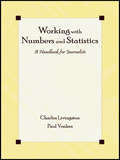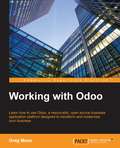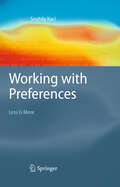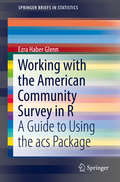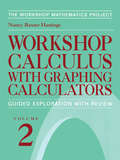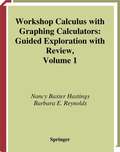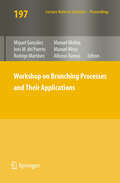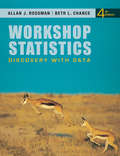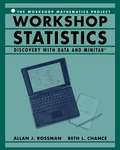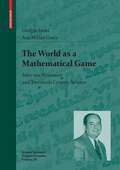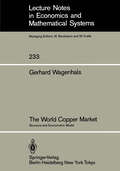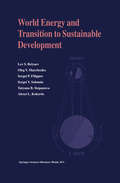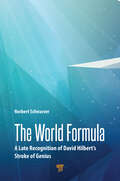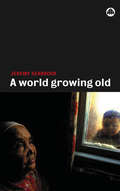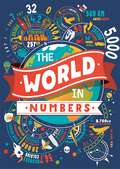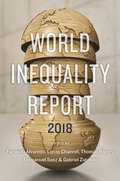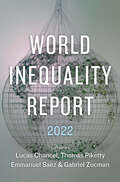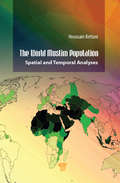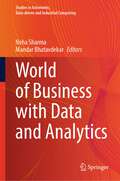- Table View
- List View
Working with Dynamical Systems: A Toolbox for Scientists and Engineers (Series in Computational Biophysics)
by Len PismenThis book provides working tools for the study and design of nonlinear dynamical systems applicable in physics and engineering. It offers a broad-based introduction to this challenging area of study, taking an applications-oriented approach that emphasizes qualitative analysis and approximations rather than formal mathematics or simulation. The author, an internationally recognized authority in the field, makes extensive use of examples and includes executable Mathematica notebooks that may be used to generate new examples as hands-on exercises. The coverage includes discussion of mechanical models, chemical and ecological interactions, nonlinear oscillations and chaos, forcing and synchronization, spatial patterns and waves. Key Features: · Written for a broad audience, avoiding dependence on mathematical formulations in favor of qualitative, constructive treatment. · Extensive use of physical and engineering applications. · Incorporates Mathematica notebooks for simulations and hands-on self-study. · Provides a gentle but rigorous introduction to real-world nonlinear problems. · Features a final chapter dedicated to applications of dynamical systems to spatial patterns. The book is aimed at student and researchers in applied mathematics and mathematical modelling of physical and engineering problems. It teaches to see common features in systems of different origins, and to apply common methods of study without losing sight of complications and uncertainties related to their physical origin.
Working with Dynamical Systems: A Toolbox for Scientists and Engineers (Series in Computational Biophysics)
by Len PismenThis book provides working tools for the study and design of nonlinear dynamical systems applicable in physics and engineering. It offers a broad-based introduction to this challenging area of study, taking an applications-oriented approach that emphasizes qualitative analysis and approximations rather than formal mathematics or simulation. The author, an internationally recognized authority in the field, makes extensive use of examples and includes executable Mathematica notebooks that may be used to generate new examples as hands-on exercises. The coverage includes discussion of mechanical models, chemical and ecological interactions, nonlinear oscillations and chaos, forcing and synchronization, spatial patterns and waves. Key Features: · Written for a broad audience, avoiding dependence on mathematical formulations in favor of qualitative, constructive treatment. · Extensive use of physical and engineering applications. · Incorporates Mathematica notebooks for simulations and hands-on self-study. · Provides a gentle but rigorous introduction to real-world nonlinear problems. · Features a final chapter dedicated to applications of dynamical systems to spatial patterns. The book is aimed at student and researchers in applied mathematics and mathematical modelling of physical and engineering problems. It teaches to see common features in systems of different origins, and to apply common methods of study without losing sight of complications and uncertainties related to their physical origin.
Working with Legacy Systems: A Practical Guide To Looking After And Maintaining The Systems We Inherit
by Robert AnnettA practical guide to looking after and maintaining the systems we inherit
Working With Numbers and Statistics: A Handbook for Journalists
by Charles Livingston Paul S. VoakesWorking With Numbers and Statistics: A Handbook for Journalists will bolster math skills and improve math confidence for journalists at all skill levels. Authors Charles Livingston and Paul Voakes developed this resource book to improve journalistic writing and reporting, enabling journalists to:*make accurate, reliable computations, which in turn enables one to make relevant comparisons, put facts into perspective, and lend important context to stories;*recognize inaccurate presentations, whether willfully spun or just carelessly relayed;*ask appropriate questions about numerical matters;*translate complicated numbers for viewers and readers in ways they can readily understand;*understand computer-assisted reporting; and*write livelier, more precise pieces through the use of numbers.The math is presented in a journalistic context throughout, enabling readers to see how the procedures will come into play in their work.Working With Numbers and Statistics is designed as a reference work for journalism students developing their writing and reporting skills. It will also serve professionals as a useful tool to improve their understanding and use of numbers in news stories.
Working With Numbers and Statistics: A Handbook for Journalists
by Charles Livingston Paul S. VoakesWorking With Numbers and Statistics: A Handbook for Journalists will bolster math skills and improve math confidence for journalists at all skill levels. Authors Charles Livingston and Paul Voakes developed this resource book to improve journalistic writing and reporting, enabling journalists to:*make accurate, reliable computations, which in turn enables one to make relevant comparisons, put facts into perspective, and lend important context to stories;*recognize inaccurate presentations, whether willfully spun or just carelessly relayed;*ask appropriate questions about numerical matters;*translate complicated numbers for viewers and readers in ways they can readily understand;*understand computer-assisted reporting; and*write livelier, more precise pieces through the use of numbers.The math is presented in a journalistic context throughout, enabling readers to see how the procedures will come into play in their work.Working With Numbers and Statistics is designed as a reference work for journalism students developing their writing and reporting skills. It will also serve professionals as a useful tool to improve their understanding and use of numbers in news stories.
Working with Odoo
by Greg MossLearn how to use Odoo, a resourceful, open source business application platform designed to transform and modernize your business About This Book • Configure, manage, and customize Odoo to fit the needs of your business • Learn about the new Odoo 8 website builder and e-commerce features that are seamlessly integrated with Odoo's business applications • Perform step-by-step configurations of the most important Odoo applications using real-world examples Who This Book Is For This book is perfect for people who have never used Odoo and for those who would like to learn about more advanced features such as creating your own custom modules. In order to get the most out of this book, you should be comfortable with downloading and installing software and understand basic business concepts such as sales, purchasing, inventory management, and basic accounting. What You Will Learn • Configure a functioning customer relationship management system • Set up a purchasing and receiving system for your company that allows you to track inventory, costs, and profit • Implement manufacturing operations and processes using real-world examples that you can put to use in your own company • Discover the capabilities of Odoo's financial accounting and reporting features • Integrate powerful human resource applications that simplify the collection and management of employee information • Utilize Odoo's full featured project management application to organize tasks and track time and costs associated with billable projects • Customize Odoo without writing a line a code In Detail Odoo continues to gain momentum throughout the world in regards to providing the best platform for open source ERP installations. Now with Odoo 8, you have access to a powerful website builder, integrated e-commerce features, and a fast-growing community to help transform and modernize your business. With this practical guide, you will cover the essential modules to get Odoo up and running for your company. After installing Odoo, you will use its sales management application to enter quotes, create sales orders, and invoice customers. You will then learn how to integrate the CRM application to manage your leads and convert them into lucrative opportunities and sales. Next, you will set up your own purchase management system, assigning products to suppliers and tracking orders with the new warehouse management and routing system. Finally, you will learn how to use analytics to track project expenses and keep your accounts simple and easy to maintain and build an Odoo module to extend its functionality and make it work for you. Working with Odoo covers all the core installation and usage functionalities of this popular tool, helping you to fully implement a working ERP system through practical, advanced, real-world examples. Style and approach This book is a practical guide that uses real-world examples to teach you how to implement Odoo into your business.
Working with Preferences: Less Is More (Cognitive Technologies)
by Souhila KaciPreferences are useful in many real-life problems, guiding human decision making from early childhood up to complex professional and organizational decisions. In artificial intelligence specifically, preferences is a relatively new topic of relevance to nonmonotonic reasoning, multiagent systems, constraint satisfaction, decision making, social choice theory and decision-theoretic planning The first part of this book deals with preference representation, with specific chapters dedicated to representation languages, nonmonotonic logics of preferences, conditional preference networks, positive and negative preferences, and the study of preferences in cognitive psychology. The second part of the book deals with reasoning with preferences, and includes chapters dedicated to preference-based argumentation, preferences database queries, and rank-ordering outcomes and intervals. The author concludes by examining forthcoming research perspectives. This is inherently a multidisciplinary topic and this book will be of interest to computer scientists, economists, operations researchers, mathematicians, logicians, philosophers and psychologists.
Working with the American Community Survey in R: A Guide to Using the acs Package (SpringerBriefs in Statistics)
by Ezra Haber GlennThis book serves as a hands-on guide to the "acs" R package for demographers, planners, and other researchers who work with American Community Survey (ACS) data. It gathers the most common problems associated with using ACS data and implements functions as a package in the R statistical programming language. The package defines a new "acs" class object (containing estimates, standard errors, and metadata for tables from the ACS) with methods to deal appropriately with common tasks (e.g., creating and combining subgroups or geographies, automatic fetching of data via the Census API, mathematical operations on estimates, tests of significance, plots of confidence intervals).
Workshop Calculus with Graphing Calculators: Guided Exploration with Review (Textbooks in Mathematical Sciences)
by Nancy Baxter HastingsBased on the use of graphing calculators by students enrolled in calculus, there is enough material here to cover precalculus review, as well as first-year single variable calculus topics. Intended for use in workshop-centered calculus courses, and developed as part of the well-known NSF-sponsored project, the text is for use with students in a math laboratory, instead of a traditional lecture course. There are student-oriented activities, experiments and graphing calculator exercises throughout the text. The authors themselves are well-known teachers and constantly striving to improve undergraduate mathematics teaching.
Workshop Calculus with Graphing Calculators: Guided Exploration with Review (Textbooks in Mathematical Sciences)
by Nancy Baxter Hastings Barbara E. ReynoldsBased on the popular "Workshop Approach", which has been hailed by the community for its hands on approach, these new versions of the popular Workshop Calculus allow the easy incorporation of a graphing calculator. Like the originals, these volumes cover topics in calculus while simultaneously reviewing precalculus concepts. Activities, experiments, and exercises are found throughout.
Workshop on Branching Processes and Their Applications (Lecture Notes in Statistics #197)
by Miguel González Inés M. Puerto Rodrigo Martínez Manuel Molina Manuel Mota Alfonso RamosOne of the charms of mathematics is the contrast between its generality and its applicability to concrete, even everyday, problems. Branching processes are typical in this. Their niche of mathematics is the abstract pattern of reproduction, sets of individuals changing size and composition through their members reproducing; in other words, what Plato might have called the pure idea behind demography, population biology, cell kinetics, molecular replication, or nuclear ?ssion, had he known these scienti?c ?elds. Even in the performance of algorithms for sorting and classi?cation there is an inkling of the same pattern. In special cases, general properties of the abstract ideal then interact with the physical or biological or whatever properties at hand. But the population, or bran- ing, pattern is strong; it tends to dominate, and here lies the reason for the extreme usefulness of branching processes in diverse applications. Branching is a clean and beautiful mathematical pattern, with an intellectually challenging intrinsic structure, and it pervades the phenomena it underlies.
Workshop Statistics: Discovery with Data
by Allan J. Rossman Beth L. ChanceAllan Rossman's 4th Edition of Workshop Statistics: Discovery with Data is enhanced from previous issues with more focus and emphasis on collaborative learning. It further requires student observation, and integrates technology for gathering, recording, and synthesizing data. The text offers more flexibility in selecting technology tools for classrooms primarily using technologies other than graphing calculators or Fathom Dynamic Data software. Furthermore, it presents more standards for teaching statistics in an innovative, investigative, and accessible as well as provides in-depth guidance and resources to support active learning of statistics and includes updated real data sets with everyday applications in order to promote statistical literacy.
Workshop Statistics: Discovery With Data and Minitab (Textbooks in Mathematical Sciences)
by Allan J. Rossman Beth L. ChanceShorn of all subtlety and led naked out of the protec tive fold of educational research literature, there comes a sheepish little fact: lectures don't work nearly as well as many of us would like to think. -George Cobb (1992) This book contains activities that guide students to discover statistical concepts, explore statistical principles, and apply statistical techniques. Students work toward these goals through the analysis of genuine data and through inter action with one another, with their instructor, and with technology. Providing a one-semester introduction to fundamental ideas of statistics for college and advanced high school students, Warkshop Statistics is designed for courses that employ an interactive learning environment by replacing lectures with hands on activities. The text contains enough expository material to stand alone, but it can also be used to supplement a more traditional textbook. Some distinguishing features of Workshop Statistics are its emphases on active learning, conceptual understanding, genuine data, and the use of technology. The following sections of this preface elaborate on each of these aspects and also describe the unusual organizational structure of this text.
The World as a Mathematical Game: John von Neumann and Twentieth Century Science (Science Networks. Historical Studies #38)
by Giorgio Israel Ana Millán GascaGalileo and Newton’s work towards the mathematisation of the physical world; Leibniz’s universal logical calculus; the Enlightenment’s mathématique sociale. John von Neumann inherited all these aims and philosophical intuitions, together with an idea that grew up around the Vienna Circle of an ethics in the form of an exact science capable of guiding individuals to make correct decisions. With the help of his boundless mathematical capacity, von Neumann developed a conception of the world as a mathematical game, a world globally governed by a universal logic in which individual consciousness moved following different strategies: his vision guided him from set theory to quantum mechanics, to economics and to his theory of automata (anticipating artificial intelligence and cognitive science). This book provides the first comprehensive scientific and intellectual biography of John von Neumann, a man who perhaps more than any other is representative of twentieth century science.
The World Copper Market: Structure and Econometric Model (Lecture Notes in Economics and Mathematical Systems #233)
by G. Wagenhals1.1 The Importance of Copper Copper, the red metal, has been known in histor~ for thousands of ~ears. It ma~ have been mankind's first metal (Joralemon= 1973). And still, probabl~ more than one hundred decades after native copper was used for the first time (Muhl~ (1973: 171», toda~, copper is a ver~ important commodit~: 1. Onl~ aluminum (first in 1963) surpasses refined copper in terms of the total 1 world's mine production and consumption. It outpaces zinc, lead, nickel and tin • 2. Refined copper is one of the most important export products of the developing countries. In 1975, refined copper ranked 8th in the developing countries' export values in general, it was 6th among their non-fuel exports, and their most important export 2 commodit~ among the non-ferrous metals • 3. Man~ small and medium sized industrialized countries depend heavil~ on copper imports. For example, West German~'s share in world mine production has alwa~s been smaller than 0.1 per cent. In the last few decades, however, the Federal Republic's consumption share has amounted to some 8 i. in 1982. 4. Copper is of utmost importance for the export earnings of several countries.
World Energy and Transition to Sustainable Development
by Lev S. Belyaev Oleg V. Marchenko Sergei P. Filippov Sergei V. Solomin Tatyana B. Stepanova Alexei L. KokorinThis book presents the results of a study of long-term perspectives for energy development of the world and its main regions, performed at the Siberian Energy Institute of the Russian Academy of Sciences (Energy Systems Institute since 1998). The methodological approach, the 10-regional Global Energy Model (GEM-10R) of the world energy system, energy demand forecasts, data on energy resources and energy technologies, and results of calculations based on mathematical models are described. Particular attention is given to determination of energy requirements and peculiarities of its technological structure that are caused by mankind's necessary transition to sustainable development. Economic and ecological consequences of constraints on greenhouse gas emissions and scales of nuclear energy production, as well as assistance of developed countries to developing ones are investigated. Problems of cheap oil, gas and uranium resources depletion, fuel price growth, synthetic fuel production and new energy technology implementation are analysed. The book is intended for specialists in energy and economics, as well as students and postgraduate students of technical high schools and universities. ac
The World Formula: A Late Recognition of David Hilbert‘s Stroke of Genius
by Norbert SchwarzerSurely the reader had come across situations where he would have given his life to get the “final answer”, the reason for our existence, a Theory of Everything, a true World Formula that contains it all… So did the author of this book. There was this deep-seated and forever unquenchable thirst for fundamental explanations on the one hand, and then there was this very special motivation from somebody else who needed this knowledge, on the other: “How to explain the world to my dying child?” Perhaps this provided the driving force to actually start this million-mile-long journey with the first small—and very tentative—step. Considering all the efforts taken, money spent, disputes fought, papers and books written, and conferences held, it is almost shocking to find that, in principle, the World Formula was already there. It was David Hilbert who wrote it down during World War I in November 1915. The complexity of the math involved was not the only thing that obscured what should have been obvious. This book explains why apparently only very few people had realized his immortal stroke of genius.
The World Formula: A Late Recognition of David Hilbert‘s Stroke of Genius
by Norbert SchwarzerSurely the reader had come across situations where he would have given his life to get the “final answer”, the reason for our existence, a Theory of Everything, a true World Formula that contains it all… So did the author of this book. There was this deep-seated and forever unquenchable thirst for fundamental explanations on the one hand, and then there was this very special motivation from somebody else who needed this knowledge, on the other: “How to explain the world to my dying child?” Perhaps this provided the driving force to actually start this million-mile-long journey with the first small—and very tentative—step. Considering all the efforts taken, money spent, disputes fought, papers and books written, and conferences held, it is almost shocking to find that, in principle, the World Formula was already there. It was David Hilbert who wrote it down during World War I in November 1915. The complexity of the math involved was not the only thing that obscured what should have been obvious. This book explains why apparently only very few people had realized his immortal stroke of genius.
A World Growing Old
by Jeremy SeabrookFor the first time in history, the world's population is ageing. For rich countries in the west, economies rely on youthful populations to provide for those who have retired. We face a profound economic and social crisis - how do we care for the elderly when pensions and social security systems are under threat, housing is short and fewer young people are entering the workplace? *BR**BR*Yet this is only half the story. Populations in the poorer countries of the South are also ageing. Life-expectancy has increased due the availability of lifesaving medicine. Child mortality has decreased, so people are having smaller families. India will soon have one of the largest populations of over-sixties. The one-child policy in China will similarly lead to a severe imbalance in the age-profile of the people. *BR**BR*In A World Grown Old, Jeremy Seabrook examines the real implications of the ageing phenomenon and challenges our preconceptions about how it should be tackled. Arguing that the accumulated skills of the elderly should be employed to enrich society, rather than being perceived as a 'burden', he calls for a radical rethinking of our attitude to population issues, migration, social structures and employment policy.
The World in Numbers
by Clive Gifford Marianne Taylor Steve MartinA quirky, full-colour illustrated book jam-packed with over 2,000 fascinating figures and facts, The World in Numbers lets figures do the talking.Each themed, colourful page is crammed with tonnes of fascinating number-led facts. Discover how fast a sneeze travels, how many Earths could fit inside the Sun, the size of a T-rex’s teeth and much, much more. From animals and adventures, to fashion, food, bugs and buildings — there’s something for everyone in this brilliant book. Featuring light-hearted illustrations by Andrew Pinder.
The World Inequality Report: 2018
by Facundo AlvaredoThe World Inequality Report: 2018 is the most authoritative and up-to-date account of global trends in inequality. Researched, compiled, and written by a team of the world’s leading economists of inequality, it presents—with unrivaled clarity and depth—information and analysis that will be vital to policy makers and scholars everywhere. Inequality has taken center stage in public debate as the wealthiest people in most parts of the world have seen their share of the economy soar relative to that of others, many of whom, especially in the West, have experienced stagnation. The resulting political and social pressures have posed harsh new challenges for governments and created a pressing demand for reliable data. The World Inequality Lab at the Paris School of Economics and the University of California, Berkeley, has answered this call by coordinating research into the latest trends in the accumulation and distribution of income and wealth on every continent. This inaugural report analyzes the Lab’s findings, which include data from major countries where information has traditionally been difficult to acquire, such as China, India, and Brazil. Among nations, inequality has been decreasing as traditionally poor countries’ economies have caught up with the West. The report shows, however, that inequality has been steadily deepening within almost every nation, though national trajectories vary, suggesting the importance of institutional and policy frameworks in shaping inequality. The World Inequality Report: 2018 will be a key document for anyone concerned about one of the most imperative and contentious subjects in contemporary politics and economics.
World Inequality Report 2022
by Lucas Chancel, Thomas Piketty, Emmanuel Saez and Gabriel ZucmanProduced by a team of world-leading economists, this is the benchmark account of recent and historical trends in inequality.World Inequality Report 2022 is the most authoritative and comprehensive account available of global trends in inequality. Researched, compiled, and written by a team of world-leading economists, the report builds on the pioneering edition of 2018 to provide policy makers and scholars everywhere up-to-date information about an ever broader range of countries and about forms of inequality that researchers have previously ignored or found hard to trace.Over the past decade, inequality has taken center stage in public debate as the wealthiest people in most parts of the world have seen their share of the economy soar relative to that of others. The resulting political and social pressures have posed harsh new challenges for governments and created a pressing demand for reliable data. The World Inequality Lab, housed at the Paris School of Economics and the University of California, Berkeley, has answered this call by coordinating research into the latest trends in the accumulation and distribution of income and wealth on every continent. This new report not only extends the lab’s international reach but provides crucial new information about the history of inequality, gender inequality, environmental inequalities, and trends in international tax reform and redistribution.World Inequality Report 2022 will be a key document for anyone concerned about one of the most imperative and contentious subjects in contemporary politics and economics.
The World Muslim Population: Spatial and Temporal Analyses
by Houssain KettaniThe birth of Islam over fourteen centuries ago was a monumental event in human history with an everlasting effect on humanity. For centuries, researchers have contemplated on the growth and distribution of Muslims throughout the world. This book presents a reliable estimate of the world Muslim population since the inception of Islam at the start of the seventh century to the end of the twenty-first century. In this book, the world is divided into five continents, each of which is further divided into non-overlapping regions, and these in turn are divided into current countries. A centennial data estimate for each region and current country from 600 AD to 2100 AD (approximately 1 H to 1500 H) of the total population, and the corresponding Muslim population and its percentage are provided. Furthermore, the same data in decennial order from 1790 to 2100 (or 1210 H to 1520 H) is provided for each region and country. These data are summarized to be a reference for other studies and discussions related to the Muslim population.
The World Muslim Population: Spatial and Temporal Analyses
by Houssain KettaniThe birth of Islam over fourteen centuries ago was a monumental event in human history with an everlasting effect on humanity. For centuries, researchers have contemplated the growth and distribution of Muslims throughout the world. This book presents a reliable estimate of the world Muslim population since the inception of Islam at the start of the seventh century to the end of the twenty-first century. In this book, the world is divided into five continents, each of which is further divided into non-overlapping regions, and these in turn are divided into current countries. A centennial data estimate for each region and current country from 600 AD to 2100 AD (approximately 1 H to 1500 H) of the total population, and the corresponding Muslim population and its percentage are provided. Furthermore, the same data in decennial order from 1790 to 2100 (or 1210 H to 1520 H) are provided for each region and country. These data are summarized to be an accurate reference for other studies and discussions related to the Muslim population. Written for demographers, researchers, historians, as well as general readers, this book is an essential reference to all aspects of the world Muslim population.
World of Business with Data and Analytics (Studies in Autonomic, Data-driven and Industrial Computing)
by Neha Sharma Mandar BhatavdekarThis book covers research work spanning the breadth of ventures, a variety of challenges and the finest of techniques used to address data and analytics, by subject matter experts from the business world. The content of this book highlights the real-life business problems that are relevant to any industry and technology environment. This book helps us become a contributor to and accelerator of artificial intelligence, data science and analytics, deploy a structured life-cycle approach to data related issues, apply appropriate analytical tools & techniques to analyze data and deliver solutions with a difference. It also brings out the story-telling element in a compelling fashion using data and analytics. This prepares the readers to drive quantitative and qualitative outcomes and apply this mindset to various business actions in different domains such as energy, manufacturing, health care, BFSI, security, etc.


